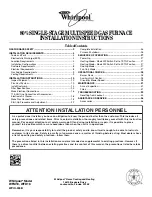
SYSTEM OPERATION
12
As an alternative to PVC pipe, primer, solvent cement, and
fittings, ABS materials which are in compliance with the following
specifications may be used. Two-or-three-inch ABS Schedule
40 pipe must meet ASTM D1527 and, if used in Canada, must
be CSA listed. Solvent cement for ABS to ABS joints must meet
ASTM D2235 and, if used in Canada, must be CSA listed. The
solvent cement for the PVC to ABS transition joint must meet
ASTM D3138. Fittings must be DWV type fittings meeting ASTM
D2661 and ASTM D3311 and, if used in Canada, must be CSA
listed. Carefully follow the manufacturers’ instructions for cutting,
cleaning, and solvent cementing PVC and/or ABS.
All 90° elbows must be medium radius (1/4 bend DWV) or long
radius (Long sweep 1/4 bend DWV) types conforming to ASTM
D3311. A medium radius (1/4 bend DWV) elbow measures 3
1/16” minimum from the plane of one opening to the center line
of the other opening for 2” diameter pipe, and 4 9/16” minimum
for 3” pipe.
Proper Vent/Flue and Combustion Air Piping
Practices
Adhere to these instructions to ensure safe and proper furnace
performance. The length, diameter, and number of elbows of the
vent/flue pipe and combustion air pipe (when applicable) affects
the performance of the furnace and must be carefully sized. All
piping must be installed in accordance with local codes and these
instructions.
T
O
AVOID
BODILY
INJURY
,
FIRE
OR
EXPLOSION
,
SOLVENT
CEMENTS
MUST
BE
KEPT
AWAY
FROM
ALL
IGNITION
SOURCES
(
I
.
E
.,
SPARKS
,
OPEN
FLAMES
,
AND
EXCESSIVE
HEAT
)
AS
THEY
ARE
COMBUSTIBLE
LIQUIDS
.
A
VOID
BREATHING
CEMENT
VAPORS
OR
CONTACT
WITH
SKIN
AND
/
OR
EYES
.
WARNING
PREFERRED
Figure 4
Figure 4
TRANSITION NO LESS
THAN 45 DEGREES TO
HORIZONTAL PLANE TO
AVOID CREATING A WATER
TRAP IN VENT PIPING.
ACCEPTABLE
Figure 5
Figure 5
NO TRANSITION ON
HORIZONTAL PLANE,
THIS CREATES A
WATER TRAP AND
RESTRICTS FLUE
GASES
Figure 6
Figure 6













































